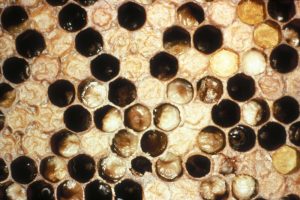American foulbrood (AFB) and European foulbrood (EFB), despite their names, both occur in the UK and both can lead to the death of infected colonies. Both foulbroods are statutory notifiable diseases and therefore, beekeepers are legally obligated to report any suspected diseased colonies under the Bee Diseases and Pests Control Order 2006 (as amended).
Causes
AFB is caused by a spore forming bacterium called Paenibacillus larvae. These spores are the infective stage of the disease and infection begins when food contaminated with spores are fed to larvae by the nurse bees. Once in the gut of the larva the spores germinate, bacteria move into the larval tissues, where they multiply enormously. Infected larvae normally die after the cell is sealed and millions of infective spores form in their remains. P. larvae spores remain viable for many years. They are very resistant to extremes of hot and cold, and to many disinfectants.
EFB is caused by the bacterium Melissococcus plutonius. Larvae become infected by consuming contaminated food fed by the nurse bees. The bacteria multiply within the larval gut, competing with it for food. They remain in the gut and do not invade larval tissue; larvae that die from the disease do so because they have been starved of food. This normally occurs shortly before the cells are capped.

Symptoms of Foulbrood
Symptoms of AFB
The characteristic disease signs of AFB include some or all of the following:
- Uneven or ‘Pepper-pot’ brood pattern;
- Sunken, greasy or perforated, darkened cell cappings;
- Roping, sticky larval remains when drawn out with a matchstick;
- Dark ‘scales’, which are difficult to remove from cells.
Symptoms of EFB
An infected colony may show some or all of the signs below:
- Erratic or uneven brood pattern;
- Twisted larvae with creamy-white guts visible through the body wall;
- Melted down, yellowy white larvae;
- An unpleasant sour odour;
- Loosely-attached brown scales;
- Unlike AFB, the remains of larvae that die from EFB do not rope when drawn out with a matchstick.

Spread of Foulbrood
The most common way in which foulbrood transmits from infected colony to healthy colony is the beekeeper. This can occur when frames of honey or brood are moved between colonies, or if other contaminated equipment is used. However, robbing by adult bees of dead or dying infected colonies is also an important mode of transmission. Swarms from infected colonies may also carry infection with them.
Precautions to take if you suspect your colony has foulbrood:
- Close the hive.
- Reduce the hive entrance to prevent robbing – take other steps if necessary.
- Disinfect your beekeeping equipment and gloves before examining other colonies, or if you use disposable gloves, select a new pair;
- Either contact your local Bee Inspector immediately or the NBU office.
- Do not remove any colonies, equipment or honey from the site until the disease (if confirmed) has been controlled. This is a self-imposed ‘Standstill’ which is a requirement under the legislation.
Control of Foulbrood
Control of AFB
All infected colonies are destroyed. The first stage is to destroy the adult bees and brood combs by burning, then the hives and any appliances are sterilised by scorching with a blow lamp or sterilising with appropriate chemicals.
Control of EFB
There are three options available to the beekeeper in the UK who has colonies infected with EFB:
1. The colonies may be treated with the shook swarm husbandry method. In trials conducted by the National Bee Unit showed that shook swarm is more successful than oxytetracycline (OTC) for the control of EFB in England and Wales. In the Spring following treatment, shaken colonies were three times less likely to test positive for M. plutonius. This finding appears logical since OTC treatment does not remove the aetiological agent present in the hive. In contrast, the shook swarm method provides the bees with M. plutonius-free material. In addition, OTC treated colonies were five times more likely to show recurrence of EFB the following year than shook swarm treated colonies.
2. The colonies may be treated with the antibiotic oxytetracycline (OTC; as the formulation Terramycin®);
3. The colonies may be destroyed, as for AFB. This will be carried out if the colony is too small for other treatment methods, is too heavily infected to respond to treatment, or at the beekeepers request.
However, the range of options available will also depend upon the time of year that the disease is diagnosed and other factors such as the strength of the colony or the level of infection. Should EFB be diagnosed in your bees, these options will be fully explained to you by your local Appointed Bee Inspector (ABI) to allow the best course of action to be taken.
Further Information
- Further details about these diseases can be found in theFoulbrood Disease of Honey Bees and other common brood disordersadvisory leaflet published by the NBU;
- More information is available on the World Organisation for Animal Health (OIE) chapters forAFBand EFB;
- For more information on cleaning your hives and other equipment, please see the NBU PDFHive Cleaning and Sterilisation;
- Information on the statutory inspection programme can be found on theApiary inspections pages
Adapted from BeeBase, National Bee Unit, Animal Health and Plant Agency (APHA) under the terms of the Open Government Licence (OGL). Crown Copyright.